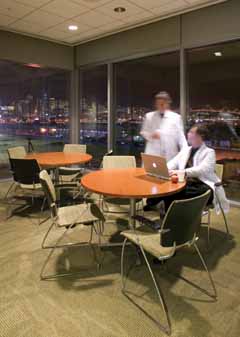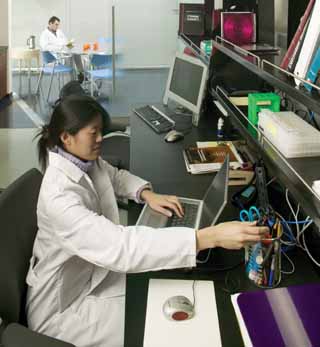
DJC.COM
March 3, 2005
Form follows function, even for biotech
NBBJ

Photos by John Durant
‘Third places’ — gathering areas away from private offices or laboratories — allow scientists, shown here in a $74 million Gladstone Institutes building in San Francisco, to collaborate.
|
While medical and technological advances are causing continual flux within the biotechnology industry, the designs of the facilities in which scientists and researchers perform their work have remained relatively unchanged. Only in recent years — as biotech has expanded in the Puget Sound region — have such buildings in our area begun to blossom, bringing with them design elements that speak specifically to the nuances of the industry.
Biotech companies have historically made do with retrofitted warehouses or renovated office buildings to house their laboratories and research space, opting to funnel the bulk of their resources into the study of their science. Regions in which the biotech industry is now being recognized for its market potential — San Francisco, San Diego and Cambridge, Mass., for example — have recognized the benefits tailored biotech space can provide. Seattle — with a growing biotech hotbed in the South Lake Union area — is beginning to do the same.
With new construction comes the opportunity to design to the trade; to essentially start from scratch and create a facility that not only accommodates equipment but encourages efficiency, fosters creativity and improves the quality of life for its inhabitants and the surrounding community. Flexibility for landlords and tenants is vital in a market that changes rapidly as science evolves. But whenever quality of life is enhanced — with amenities such as cafes, retail, and childcare — employees are more likely to become ingrained in the company's culture, as well as in the community.
Moving forward
The evolution of science, combined with a growing understanding of biotech design, is changing the way scientists and technicians work. While corporate office design has undergone several transformational cycles, from enclosed rabbit warrens to open plan landscape, hot-desking and home-working, laboratory design has yet to complete one cycle.
In biotech's infancy, "wet" lab space with an office for the principal investigator was the norm. As the use of computing systems grew, so did the need for "dry" lab space. Here, technicians create mathematical models and virtual testing systems — without a beaker or microscope in sight. The availability of electronic information is key, requiring robust technology infrastructure. And in an industry fueled by great minds, attracting and retaining top employees is of utmost importance. These days, it takes more than a gold watch or an extra day's pay to keep the best employees from heading to greener pastures. A holistic approach to the design of biotech facilities is becoming a necessary practice.
Three-pronged approach:
Biotech-specific designs include intense flooring stabilization to greatly minimize vibrations that could affect sensitive instruments. The typical measurement of velocity allowed in an office building — that is, the measurement of a floor's vibration characteristics — is 32,000 microinches per second. In a biotech facility, it's a mere 2,000 microinches per second.
The mechanical requirements of a biotech building are also much more demanding than that of a typical commercial building. With air circulation needs twice that of an office building, a biotech facility requires larger air shafts and space for exhaust and intake fans. Without planning ahead, the space needed for such infrastructure could easily interrupt the natural flow of work.
Biotech firms are realizing that the bottom line increasingly hinges on the caliber of their staff. Owners are asking architects to design attractive and fun places to work to help lure talented employees. Along with the most efficient and advanced equipment, new biotech facilities often feature on-campus athletic facilities, carefully designed landscaping, artistic installations and stunning views.

The evolution of science has changed the way scientists and technicians work. New biotech architecture includes considerable ‘dry’ lab space where technicians can create virtual testing systems electronically. NBBJ designed this building for the J. David Gladstone Institutes in San Francisco.
|
Once employees have been hired, they need reasons to stay. Understanding how scientists best work is key to designing effective spaces. "Third places" — informal gathering areas on common ground — allow biotech workers space to freely discuss projects and exchange ideas. The opportunity to collaborate on neutral territory is key to opening communication. It is within these interactions that the culture of the company is born.
There are still relatively few developers pursuing biotech projects. Alexandria Real Estate Equities and Slough Estates are leading the way in the Mission Bay area of San Francisco — a targeted location due to its proximity to the University of California's brain power, and a kind of prototype for South Lake Union with the University of Washington as a neighbor.
As the Puget Sound region's biotech hub continues to grow, it's certain to evolve into an area highly respected for its talented workforce and cutting-edge studies. With facilities specifically designed to foster such talent and encourage scientific discovery, one could expect nothing less.
Bradley D. Leathley is a principal and Mark A. Whiteley is a senior associate at Seattle architecture firm NBBJ, specializing in the design of biotech facilities throughout the world.
Other Stories:
- Building a foundation for biotech
- Can Seattle become a first-tier biotech hub?
- Laptops, Treos and phones! (Oh my!)
- Build it right and they will come
- New buildings bring science into the city
- How one local developer took the biotech plunge
- 6 myths about building for biotech
Copyright ©2009 Seattle Daily Journal and DJC.COM.
Comments? Questions? Contact us.